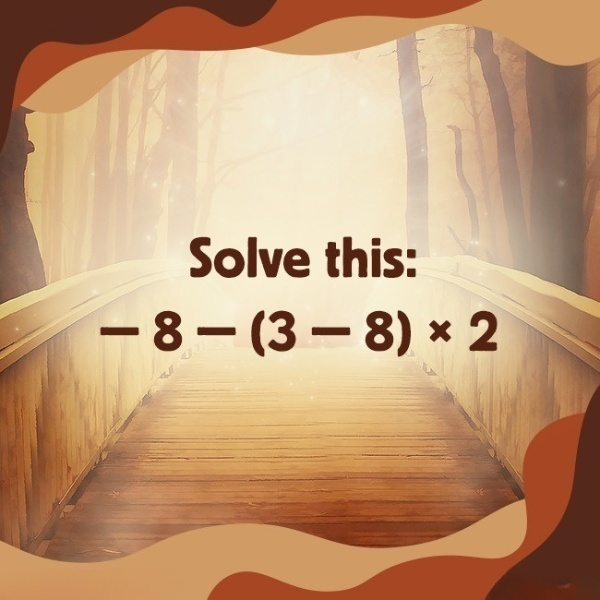Are you ready to challenge your math skills with a deceptively tricky equation? Today’s puzzle, -8 – (3 – 8) × 2 = ?, might look simple at first glance, but don’t let its straightforward appearance fool you. Many stumble on problems like this due to overlooked details or forgotten math rules. Before diving into the solution, give it a try. What’s your answer? Let’s break it down step by step to ensure you not only solve it but truly understand the logic behind it.
Common Mistakes in Math Puzzles

Before tackling the problem, let’s address some common pitfalls that often trip people up with equations like this:
- Forgetting the Order of Operations
The biggest mistake people make is ignoring PEMDAS/BODMAS (Parentheses, Exponents, Multiplication and Division, Addition and Subtraction). This rule dictates the correct sequence for solving equations. - Misinterpreting Negative Numbers
Negative numbers can be tricky, especially when combined with subtraction or parentheses. Missteps in handling these can lead to wildly incorrect answers. - Skipping Steps
Trying to solve too quickly or mentally skipping intermediary steps can easily result in errors. - Overthinking
Sometimes, a seemingly simple problem causes people to second-guess themselves, leading to overcomplication.
Sound familiar? Don’t worry—these are all fixable. Let’s tackle this equation step by step.
Step-by-Step Solution to -8 – (3 – 8) × 2
Let’s solve the problem logically, following the proper order of operations.
Step 1: Resolve the Parentheses
The first step is to simplify everything inside the parentheses. In this case, we have:
3 – 8 = -5
So, the equation becomes:
-8 – (-5) × 2
Step 2: Perform the Multiplication
Next, handle the multiplication. According to PEMDAS, multiplication comes before subtraction. Multiply -5 × 2:
-5 × 2 = -10
Now substitute this result back into the equation:
-8 – (-10)
Step 3: Subtract the Negative Number
Here’s where many people falter—subtracting a negative number. Subtracting a negative is equivalent to adding the positive counterpart. So:
-8 – (-10) = -8 + 10
Step 4: Perform the Final Addition
Now, simply add the numbers:
-8 + 10 = 2
The correct answer is: 2.

Why This Puzzle Is Tricky
Even though the math itself is straightforward, this puzzle often stumps people. Why? Let’s break it down:
- Double Negatives
Subtracting a negative number isn’t something we encounter often, so it’s easy to forget that it converts into addition. - Order of Operations
Ignoring PEMDAS and solving the equation from left to right leads to errors. For example, some might incorrectly subtract -8 – 3 before handling the multiplication. - Mental Shortcuts
In a rush to solve, people might skip writing out intermediate steps, increasing the likelihood of mistakes.
Recognizing these common errors can help you approach similar problems with greater confidence.
The Value of Math Puzzles
Why bother with math puzzles like this? Beyond the satisfaction of finding the correct answer, they offer a range of benefits for your brain:
- Improved Logical Thinking
Puzzles train you to approach problems systematically and apply rules correctly. - Increased Attention to Detail
Careful examination of each step ensures accuracy, a skill that translates to other areas of life. - Enhanced Problem-Solving Skills
Regularly tackling puzzles sharpens your ability to think critically and identify patterns. - Mental Discipline
Working through challenges builds patience and persistence—qualities that pay off in both academic and professional settings.
Plus, puzzles like this are a fun way to engage your friends or family. Who doesn’t love a little friendly competition to see who can solve the fastest?
How Did You Do?
Did you arrive at the correct answer of 2, or did one of the common mistakes catch you off guard? Share your process with others and compare strategies. Discussing solutions is a great way to solidify your understanding and learn new approaches.
Challenge Your Friends
Think you’ve mastered this puzzle? Share it with your friends and family! Math puzzles make excellent conversation starters and can even spark a bit of friendly rivalry. Who can solve it the fastest, and who will need a second attempt?
Conclusion: Keep Practicing and Improving
Math puzzles like -8 – (3 – 8) × 2 = ? may seem simple, but they’re a great way to test your problem-solving skills and reinforce foundational concepts. Whether you nailed it or learned from a mistake, each attempt builds your confidence and sharpens your brain.
So, don’t stop here—explore more puzzles, riddles, and challenges to keep your mind sharp and your problem-solving abilities at their peak. With every equation you solve, you’re not just learning math—you’re training yourself to think critically and methodically in all areas of life.
Ready for the next challenge? Keep solving, keep sharing, and most importantly, keep having fun!


